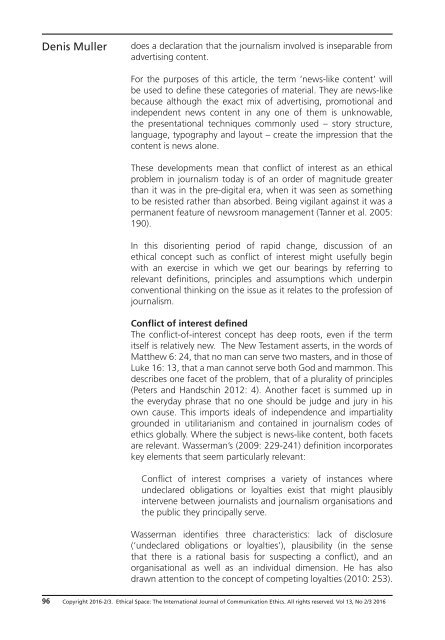Beyond clickbait and commerce
v13n2-3
v13n2-3
Create successful ePaper yourself
Turn your PDF publications into a flip-book with our unique Google optimized e-Paper software.
Denis Muller<br />
does a declaration that the journalism involved is inseparable from<br />
advertising content.<br />
For the purposes of this article, the term ‘news-like content’ will<br />
be used to define these categories of material. They are news-like<br />
because although the exact mix of advertising, promotional <strong>and</strong><br />
independent news content in any one of them is unknowable,<br />
the presentational techniques commonly used – story structure,<br />
language, typography <strong>and</strong> layout – create the impression that the<br />
content is news alone.<br />
These developments mean that conflict of interest as an ethical<br />
problem in journalism today is of an order of magnitude greater<br />
than it was in the pre-digital era, when it was seen as something<br />
to be resisted rather than absorbed. Being vigilant against it was a<br />
permanent feature of newsroom management (Tanner et al. 2005:<br />
190).<br />
In this disorienting period of rapid change, discussion of an<br />
ethical concept such as conflict of interest might usefully begin<br />
with an exercise in which we get our bearings by referring to<br />
relevant definitions, principles <strong>and</strong> assumptions which underpin<br />
conventional thinking on the issue as it relates to the profession of<br />
journalism.<br />
Conflict of interest defined<br />
The conflict-of-interest concept has deep roots, even if the term<br />
itself is relatively new. The New Testament asserts, in the words of<br />
Matthew 6: 24, that no man can serve two masters, <strong>and</strong> in those of<br />
Luke 16: 13, that a man cannot serve both God <strong>and</strong> mammon. This<br />
describes one facet of the problem, that of a plurality of principles<br />
(Peters <strong>and</strong> H<strong>and</strong>schin 2012: 4). Another facet is summed up in<br />
the everyday phrase that no one should be judge <strong>and</strong> jury in his<br />
own cause. This imports ideals of independence <strong>and</strong> impartiality<br />
grounded in utilitarianism <strong>and</strong> contained in journalism codes of<br />
ethics globally. Where the subject is news-like content, both facets<br />
are relevant. Wasserman’s (2009: 229-241) definition incorporates<br />
key elements that seem particularly relevant:<br />
Conflict of interest comprises a variety of instances where<br />
undeclared obligations or loyalties exist that might plausibly<br />
intervene between journalists <strong>and</strong> journalism organisations <strong>and</strong><br />
the public they principally serve.<br />
Wasserman identifies three characteristics: lack of disclosure<br />
(‘undeclared obligations or loyalties’), plausibility (in the sense<br />
that there is a rational basis for suspecting a conflict), <strong>and</strong> an<br />
organisational as well as an individual dimension. He has also<br />
drawn attention to the concept of competing loyalties (2010: 253).<br />
96 Copyright 2016-2/3. Ethical Space: The International Journal of Communication Ethics. All rights reserved. Vol 13, No 2/3 2016


